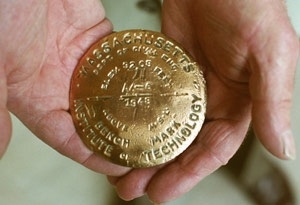More than 50 years ago, an MIT alumnus made his mark on a bridge in rural Maine. Now this small but gleaming item from the past has been reunited with its origins.
It all started on Aug. 30, 1948, when civil engineering student Philip Simmons (S.B. 1951) drilled into the concrete on a bridge in Machias, Maine and installed a small brass disc called a benchmark. This disc, three and a half inches in diameter, was used over the years by surveyors and map-makers as a reference point for determining elevations on local projects. The benchmark was engraved with the elevation (92.08 feet above sea level), date and installer (MIT civil engineering).
Since surveying was a required civil engineering subject at MIT until the late 1950s, most of the students honed their skills during an intensive summer at the department's "Camp Tech" near East Machias. Amid the rugged woods and blueberry barrens, they measured precise elevations, determined property boundaries, created topographical maps and gauged stream flow. They also installed a number of benchmarks as part of the US Geodesic Survey's national network of elevation markers.
Nothing lasts forever. The road was recently scheduled to be widened, which would have destroyed the benchmark. But Harold Nelson of the Maine Department of Transportation's survey section, seeing that the endangered piece of brass was clearly labeled "Massachusetts Institute of Technology Civil Engineering Department," saw that it was carefully removed and saved. He burnished it to a bright sheen and mailed it to Debbie Levey, editor of MIT's civil and engineering department newsletter.
Since Simmons had written to the newsletter earlier and mentioned having attended Camp Tech in 1948, Levey asked him whether he knew anything about this particular benchmark. Fortunately, he kept meticulous records. Perusing his diary from that summer, he quickly located an entry from Aug. 30: "After dinner, four of us went into Machias to put in two benchmarks. Another fellow and I put one in the bridge that crosses the Machias River." On Sept. 2, he "spent all day in Machias running first-order levels to the new benchmarks that we installed last week."
Simmons drove up from his home in East Lyme, Conn., last week to see this artifact from his past. He also donated his bound course notes from 1947-51 to Deborah Douglas at the MIT Museum, and gave copies of the Camp Tech yearbooks (appropriately called "The Benchmark") from 1948-50 to Levey.
Like many civil engineering alumni, Simmons found his surveying experience very useful for a while. He worked around the country at several heavy-construction projects, then settled down in Connecticut to manage a construction supply company.
Although Nelson has no official connection to MIT, several civil engineering alumni work with him at the Maine transportation department, and he reads the department's newsletter. References to Camp Tech often appear in its Alumni Notes column, where people reminisce about their experiences and friendships.
After the property was sold by MIT in 1957, the camp fell into disrepair. Several years ago, the BeVier family in Connecticut bought the property and is transforming it into a children's summer camp. The BeViers are interested in the camp's history and the stories behind the names scrawled on the dilapidated cabins, and have welcomed visiting alumni. Anyone with other Camp Tech stories to share may contact Levey at x3-7112 or levey@mit.edu.
A version of this article appeared in MIT Tech Talk on January 30, 2002.







